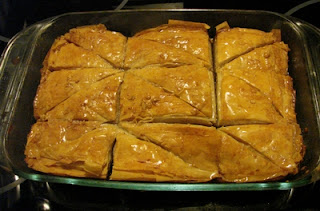Baklava (aka baklawa) is a delicious dessert, made of layers of filo (phyllo) pastry and chopped nuts; very popular in Greek, Turkish and Middle Eastern cuisine. You usually buy it commercially packaged or prepared, at grocery or specialty stores. Here, the quality can very quite a bit. It can be delicious, light and flaky, made by hand with love and honey. Or it can be dry, tasteless and crumbly, made by machines with sugar syrup, and no trace of honey. Also, many variations of baklava and similar desserts can be found in Lebanese, Iranian or Greek specialty shops. However, nobody I know actually makes it at home. Well, now, with the exception of me. And hopefully, you. This post atttempts to take the mystery out of making baklava, and once that is done, you'll see that it is really not very difficult! With the exception of the filo pastry, you may already have the ingredients on hand. You can find the filo pastry in the frozen section of supermarkets and specialty food stores. You can consider this recipe "Baklava Lite", as I am using a lot less sugar, butter, etc. than many other such recipes. This will make for a more subdued flavour, but a lot less rich and "healthyesque" than otherwise. Your heart will thank you for that small gesture.
So, give it a whirl, you'll love yourself for it. There will be plenty on hand to share, and whomever you share it with, will love you in return.
Ingredients
1 c to 21/2 c walnuts (preferably), pistachio nuts or almonds (depending on how generous you want to be with the nuts)
1 1/2 c (preferably brown) sugar
1/4 lb butter
1 package frozen filo dough pastry, fully thawed
2 cups water
1 teaspoon lemon juice
1 tablespoon rosewater
1/4 cinnamon
Before you start anything, note that the filo pastry must be completely thawed, at room temperature. (It should not feel cold at all, in the center). If not, when you go to unroll it, you will have problems, and you risk breaking it. If you try to cheat by thawing it in the microwave, you'll have problems there as well, with the delicate paper-thin layers of the filo sticking to each other. Also note that you will need some work space to work with the pastry, and its layering.
Combine the nuts with 1/2 c sugar and the cinammon in the bowl of a food processor. Process on pulse (short cycles) until the nuts are chopped up, fairly finely. That is some small nuggets remain, for texture. n.b. If you are using the bare minimum of 1c nuts, you'll want to process it longer, until almost fully crumbed, in order to stretch out the filling. In a large glass microwave-safe cup (ie. a Pyrex measuring cup), melt the butter on relatively high heat in a microwave oven (high, to avoid separation of milk and solids).
Prepare a 9 x 13 glass baking pan by lightly greasing the bottom with a bit of the melted butter. Cut the sheets of pastry (all at once), with a large knife, to fit just the bottom of the pan, so that you don't have to fold in the ends to fit the sheets. (n.b. 9 x 13 is the ideal size, but if you do not have a 9 x 13 pan, then use a smaller pan. You'll have to improvise by cutting the pastry to fit a smaller size pan). As you will be left with smaller pieces, you can at the end or during the process, criss cross the extra smaller bits over the large ones. Just make sure you save full size pieces for the last (top) layer. Start by separating two or three sheets of filo from the stack, and place at the bottom of the greased glass pan. Brush this carefully with the melted butter, using a pastry brush. n.b. Because there is much less butter, you're going to have to be very sparing in applying it. You want to just barely moisten the sheet all over, but not soak it. The sheet of filo will tend to tear up as you're brushing it, if you do not hold it down. Thus, with the pan on the vertical (short edge facing you), hold down the sheet by the edge nearest you, and brush the butter gently, and only in the direction going away from you. Use the brush to spread the melted butter more evenly, ensuring you have applied it around the edges of the sheet as well.
Mix up the processed nut mixture with a spoon, so that the sugar and nuts are more evenly mixed. After the first layer has been buttered, scoop some of the nut mixture with your fingers, and toss it over the surface of the first layer of dough (don't use much if you are only using one cup). You may if you wish to, spread the nut mixture more evenly across the surface with your fingers, but this isn't really necessary. Cover that with another layer of two sheets of filo pastry, and repeat the process of buttering the sheet, then topping it with the nut mixture. You will be repeating this process many times, until about half (or a bit more) of your filo pastry is used up. With the remaning sheets of filo, you can continue layering it as described, but without the nuts. This way the top half is just filo. But if you still have nut mixture left, you can continue layering until the nut mixture is used up. Just ensure the final layers, especially the top layer (which also needs to be buttered), is just filo.As mentioned, the last layer should be made with full size filo sheets, for aesthetics. You can also sprinkle some nut mixture on top of the top layer, if you wish.
Once the layering is finished, preheat your oven to 300F. Now, with a sharp knife, cut the pastry in three sections, both across and down, to form nine rectangles (or squares, if you're using a smaller pan). Now cut each of those rectangles in half on the diagonal, to form two triangles in each rectangular piece. You should have 18 diamond shaped pieces. If you happen to have any additional butter left, now would be a good time to pour it over the pieces. Place the pan in the middle rack of your oven, and heat for 1 hour 15 minutes, or until the entire dish is golden brown.
While it is cooking, we'll prepare the syrup. Place 2 cups of water in a medium pot, along with 1c brown sugar, 1 tablespoon lemon juice. Let boil on high, for 10 minutes (it should reduce by about half). Remove from heat, add rose water, return to boil. Once boiling, remove from heat, stir, let cool. Once the baklava has finished cooking in the oven, let cool, pour syrup over (while the syrup is still warm, and before it has a chance to completely cool). It won't taste right, eaten immediately. So refrigerate at least a couple of hours, before serving.
n.b. The rose water can be found at specialty shops or the international aisle of a supermarket. It goes a long way to adding flavour, but if you can't get it, you can go without. You can also try orange blossom water if you can get that. The use of sugared syrup does not make it better, this is simply a lower-cost recipe. So, if you wish to use honey (or even maple syrup?), you are better off doing that! As honey is thicker than sugar, when boiling the mixture, I would probably use a bit more water. The important thing is to end up with a fairly liquid syrupy consistency, that you can easily pour over the filo diamonds.










0 comments:
Post a Comment